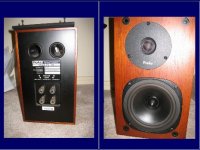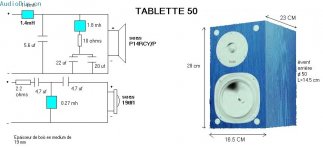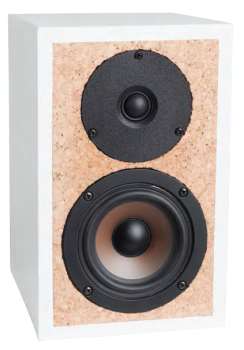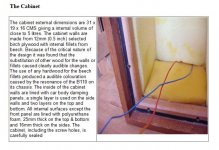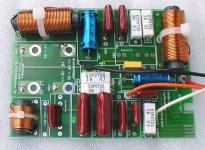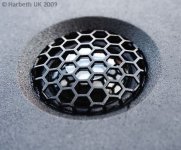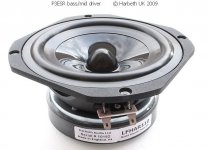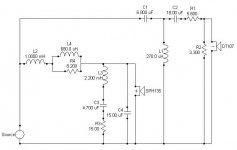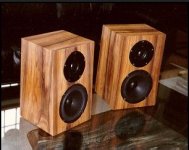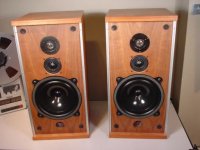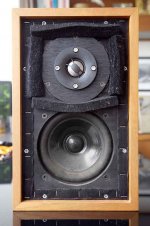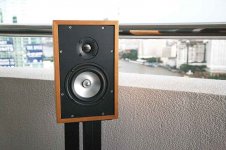SEAS P14RCY and its successors looks right to me. The Harbeth tweet looks like a variant of the aluminium SEAS 19TAFD/G which continues to irritate me in my Monitor Audio R300/MD, albeit with no ferrofluid... 🙂
H0532-08 19TAFD/G
The soft dome SEAS 19TFF1 looks better to me.
H0737-08 19TFF 1
These two drivers were also used in the Proac Tablette 50, which is an LS3/5A clone if ever I saw one. Credit Paul Yahya here for his hard investigative work:
New Kids on the Block - Surfing Music Sound-Waves
At some point you think, yeah, I'll have a bash at this! How hard is it? 😀
H0532-08 19TAFD/G
The soft dome SEAS 19TFF1 looks better to me.
H0737-08 19TFF 1
These two drivers were also used in the Proac Tablette 50, which is an LS3/5A clone if ever I saw one. Credit Paul Yahya here for his hard investigative work:
New Kids on the Block - Surfing Music Sound-Waves
At some point you think, yeah, I'll have a bash at this! How hard is it? 😀
Attachments
HaHa, Cheap Trick CT 238...yes. 4 ohm 4" bass, 19mm SEAS tweet. 🙂
Rearrange the following into a well known crossover for 4 ohm bass and non-ferro SEAS 19TFF...Reckon there might be a 8.2R/1.5uF Zobel there and 2x4.7uF/0.27mH valve friendly high pass. But I'm a bit stumped. 😕
Onwards with the current lovely MDF Harbeth Monitor 20.1 and it's studio P3ESR brother. The bass is a handsome Harbeth special, made by them from some poly material they call radius. Tweet is a modified SEAS metal dome with a different phase plate. Looks like they use double magnets for magnetic shielding and boosting field strength. Crossover is very nice, with a bolt on connection to the rear speaker terminals. Bit of a mixture of models shown here, but vented bass is good too.
Finally a shot of the LS3/5A with construction details. Hope everybody is up to speed on most of this now. FWIW, I like Troel's affordable peerless 830860 design best, and the Vifa tweeter looks easy enough to substitute with whatever takes your fancy:
Peerless HDS PPB 830860
Rearrange the following into a well known crossover for 4 ohm bass and non-ferro SEAS 19TFF...Reckon there might be a 8.2R/1.5uF Zobel there and 2x4.7uF/0.27mH valve friendly high pass. But I'm a bit stumped. 😕
1,2 mH cfc16-Kupferfolienspule
0,39 mH Backlackspule / 0,71 mm
0,27 mH Backlackspule / 1 mm
4,7 uF MKP-Kondensator/400 V
1,5 uF MKP-Kondensator/400 V
4,7 uF Mundorf MCAP-Supreme Silber-Oil-Kondensator
1,8 Ohm MOX4-Widerstand (braun-grau-gold)
4,7 Ohm MOX4-Widerstand (gelb-violett-gold)
8,2 Ohm MOX4-Widerstand (grau-rot-gold)
Onwards with the current lovely MDF Harbeth Monitor 20.1 and it's studio P3ESR brother. The bass is a handsome Harbeth special, made by them from some poly material they call radius. Tweet is a modified SEAS metal dome with a different phase plate. Looks like they use double magnets for magnetic shielding and boosting field strength. Crossover is very nice, with a bolt on connection to the rear speaker terminals. Bit of a mixture of models shown here, but vented bass is good too.
Finally a shot of the LS3/5A with construction details. Hope everybody is up to speed on most of this now. FWIW, I like Troel's affordable peerless 830860 design best, and the Vifa tweeter looks easy enough to substitute with whatever takes your fancy:
Peerless HDS PPB 830860
Attachments
This is a true copy by KEF
Constructor_Series_Model_CS1A
And there is Constructor_ Series_Model_CS1
But a believe that Constructor_Series_Model_CS3 is much better 😉
Constructor_Series_Model_CS1A
And there is Constructor_ Series_Model_CS1
But a believe that Constructor_Series_Model_CS3 is much better 😉
I have a friend who has 3 pairs of LS3/5as. Rogers, Spendor and Stirling. The Stirlings do not use Kef Drivers. He assures me that the Stirling use Monacor 135 TCs, not the ADs. The TCs (twin voice coil) look identical to the ADs but are less efficient (85dB. Not clear if this is 8 or 16ohm, ie both coils in series) and Vas 16 litres and Qt 0.42( from memory). The frequency response looks broadly identical, but smoother. Strangely they are a bit cheaper.
the stirlings look smoother than the other LS5s? I doubt that. The LS5 is a class 2 monitor (IIRC must meet +/- 1dB) The design was contracted to many companies to make the drivers box and all to the original spec (Kef?). Small variation in build quality is the most ive come across. I live with an early 80s 15 Ohm marked Goodmans, which are the infamous 'white belly' types. They really sound very good, and and any 'brand loyalty' is likely an oxymoron. The monacor SPH135 are a world away from what they emulate, or are marketed as drop in replacements for...
I have no direct contact with LS3/5as, and can only relay my friends views. I believe that Stirling were authorised to market these as LS3/5As (is this right)? My friend prefers them to his Spendors which he prefers to the Rogers. No way of knowing if the Spendors or Rogers are performing as they came out of the factory. I was not saying that the Monacors are any good, just that although Wilmslow audio recommend the ADs, Stirling use the TCs.
I've greatly enjoyed looking into this LS3/5A clone idea, and I think we've learnt what is good about the BBC cabinet design. It's light, flexible and not overly damped in fact. 🙂
Made some progress on the Monacor SPH135/AD bass notch as pictured below. It's 1.56 kHz to be precise. The rest of the crossover I would regard as a moveable feast depending how you want to do bafflestep and rolloff and I think it would be possible to work out a parallel trap equivalent. But do adjust cabinet volume for the precise driver.
The superbly flat and nicely rolled off Vifa P13WH is available still, along with the Vifa D27TG-35-06 as substitute for the retired Vifa D27TG-45-06. This oldish Esquire design is very good IMO. 4th order linkwitz-Riley filtering avoids lobing problems above and below axis in theory. It needs to be time aligned though. Pictured below.
Ah, so many variations on this BBC theme. 😎
Made some progress on the Monacor SPH135/AD bass notch as pictured below. It's 1.56 kHz to be precise. The rest of the crossover I would regard as a moveable feast depending how you want to do bafflestep and rolloff and I think it would be possible to work out a parallel trap equivalent. But do adjust cabinet volume for the precise driver.
The superbly flat and nicely rolled off Vifa P13WH is available still, along with the Vifa D27TG-35-06 as substitute for the retired Vifa D27TG-45-06. This oldish Esquire design is very good IMO. 4th order linkwitz-Riley filtering avoids lobing problems above and below axis in theory. It needs to be time aligned though. Pictured below.
Ah, so many variations on this BBC theme. 😎
Attachments
ok. I know that regardless of the contracted firm, the design spec is the same. Whether there were any later alterations im unsure. I agree with system7 in that the vifa P13 would be a good start at a clone, and i recall a wavecore that may also be worth a try, forget the model number tho. Personally i think the T27 is the harder part to 'clone'. I have yet to come across a dome, mylar or alu, that sounds half as good. There are thousands out there, many great tweeters, but none like the T27. All the 10mm and 14mm polymer domes ive heard just dont cut it. SB acoustics sb29 dimple dome is reputed to be value, the g20sc i use are also good, but lacks something the T27 has. Colouration? Couldnt say for sure.
While the D27-45-06 may be discontinued there are still good stocks of this tweeter in Australia.
It is a classic partner to the P-13 and a tweeter I have found very easy to work with and listen too.
The opinion of others on this forum is tho, that there are much better tweeters on the market. Those better tweeters are much more expensive so take your pick among the various price points
It is a classic partner to the P-13 and a tweeter I have found very easy to work with and listen too.
The opinion of others on this forum is tho, that there are much better tweeters on the market. Those better tweeters are much more expensive so take your pick among the various price points
The obsolete Vifa D27-45-06 was not a recommendation, Moondog55, just what the Esquire's complex filter was designed for. My suggested similar modern replacement was just to keep it alive. 🙂
Mondogenerator raises an interesting point about the KEF T27 mylar domed tweeter. This is clearly a different animal from today's soft domes. Robin Marshall explains the objectionable oilcan tweeter resonance issue rather well.
Let's say that plastic coned tweeters were very different from today's fabric soft domes. I recall having my (blown) Isophon KK10/8 plastic tweeters apart. Damping was a piece of BAF wadding actually glued to the dome and magnet and filling the space. Similarly Wharfedale tweeters used glued BAF in the same way. Fact was once you took them apart and broke the glue, you'd messed them up. 😱
Fabric domes use foam or felt damping material too, but it doesn't touch the dome at all and I believe the dome itself is damped. There is a saying that speakers sound like what they are made of. I suspect this is true.
I enclose the usual pictures to keep you interested. The KEF T27 spec is better than I thought. 900Hz resonance is impressive. 😀
Mondogenerator raises an interesting point about the KEF T27 mylar domed tweeter. This is clearly a different animal from today's soft domes. Robin Marshall explains the objectionable oilcan tweeter resonance issue rather well.
Let's say that plastic coned tweeters were very different from today's fabric soft domes. I recall having my (blown) Isophon KK10/8 plastic tweeters apart. Damping was a piece of BAF wadding actually glued to the dome and magnet and filling the space. Similarly Wharfedale tweeters used glued BAF in the same way. Fact was once you took them apart and broke the glue, you'd messed them up. 😱
Fabric domes use foam or felt damping material too, but it doesn't touch the dome at all and I believe the dome itself is damped. There is a saying that speakers sound like what they are made of. I suspect this is true.
I enclose the usual pictures to keep you interested. The KEF T27 spec is better than I thought. 900Hz resonance is impressive. 😀
Attachments
-
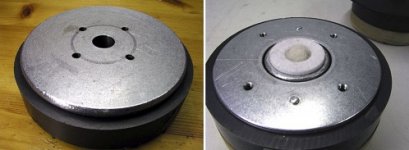 Audax_TWO34_Troels_Modified.JPG43.5 KB · Views: 164
Audax_TWO34_Troels_Modified.JPG43.5 KB · Views: 164 -
 Audax_TWO34_SoftDome_Tweeter.JPG46 KB · Views: 181
Audax_TWO34_SoftDome_Tweeter.JPG46 KB · Views: 181 -
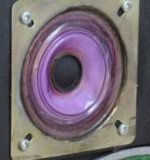 Wharfedale_Linton_Tweeter.JPG13.3 KB · Views: 783
Wharfedale_Linton_Tweeter.JPG13.3 KB · Views: 783 -
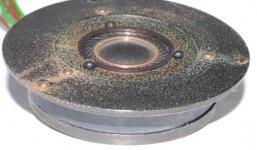 Coles_4001G_16R_SuperTweeter.JPG42.6 KB · Views: 784
Coles_4001G_16R_SuperTweeter.JPG42.6 KB · Views: 784 -
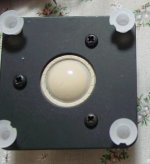 Isophon_KK10-8_mylar.JPG23 KB · Views: 2,563
Isophon_KK10-8_mylar.JPG23 KB · Views: 2,563 -
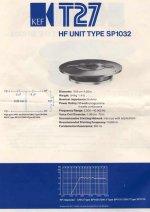 KEFDriverp6T27.jpg41.9 KB · Views: 799
KEFDriverp6T27.jpg41.9 KB · Views: 799 -
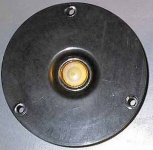 KEF-T27_Tweeter.JPG25.3 KB · Views: 857
KEF-T27_Tweeter.JPG25.3 KB · Views: 857
My understanding of the KEF HF drivers was this; they were originally designed as compression drivers, especially those with phenolic domes.
Personally I do not think the D27-45-06 is obsolete, merely that they have stopped producing it; although I would like to see it made "as is" using Neo ring magnets to retain the large rear cavity.
Personally I do not think the D27-45-06 is obsolete, merely that they have stopped producing it; although I would like to see it made "as is" using Neo ring magnets to retain the large rear cavity.
I do think you are sidetracking us here Moondog55. 🙂
IIRC the Celestion HF1300 was the compression driver:
But it seems the HF1300 was the basis of the current Vifa tweeters:
Quite interesting that the Coles 4001 supertweeter was originally a STC microphone. 😎
Edit: Good Grief. This is like discovering that fish (The Coelacanth...LOL) that was thought to have been extinct for 100 Million years. Coles still make a HF1300 equivalent. The CE 3000 Tweeter: http://www.coleselectroacoustics.com/drivece3000.shtml
IIRC the Celestion HF1300 was the compression driver:
Spendor BC1More info on the HF1300 from J. Bright in Australia.
"Love the site especially the vintage and British Spendor stuff. I have a pair of HF1300 and I have some additional information. As I understand it they were originally the 'compression' driver for a horn loaded treble unit. This was to be used with a very early METAL coned unit (8"?). It was around the mid 1950's and it was produced by GEC and the designer associated with was a person called "Brittain", I think, but I'm not absolutely 100% clear about this, but I have a pretty good memory. I used to own a copy of Gilbert Briggs book "Loudspeakers" (5th edition 1958) and there is clearly an early HF1300 in a photo of a collection of tweeters and I am pretty sure it is identified as "A GEC pressure unit". I guy in England called Royal told me that the tooling for the HF1300 was sold by Celestion to Coles who also now make the 4001 after presumably buying the rights for them from STC. If you are into speaker trivia the following might interest you also. I believe the 4001 super tweeter began life as the diaphragm in a STC microphone! You'll find both the tweeters on the Coles Acoustics website but they have developed a new metal mounting plate for the HF1300. But I'm sure it is the same mechanism behind the front frame. I also have some data and a paper on the 4" Jordan-Watts modules (I own a pair). I'll send you a copy if you are interested."
But it seems the HF1300 was the basis of the current Vifa tweeters:
Vintage HiFiThis is a strange fellow. Works well from 1.5 kHz to 13 kHz. Sounds very good but needs flush-mounting like all tweeters. The cone has a very wide suspension and it may actually be the ancestor of the modern e.g. Vifa DX25TG tweeter. But who designed the housings and who got the idea for the turbo grille in front of the diaphragm? Do you know the story behind this design, please tell me. Martin Colloms has some details on the tweeter in his book. Excerpt at the BC1 page.
Quite interesting that the Coles 4001 supertweeter was originally a STC microphone. 😎
Edit: Good Grief. This is like discovering that fish (The Coelacanth...LOL) that was thought to have been extinct for 100 Million years. Coles still make a HF1300 equivalent. The CE 3000 Tweeter: http://www.coleselectroacoustics.com/drivece3000.shtml
Last edited:
interesting, it does indeed look like a mic or headphone insert. Someone got something right years ago, that maybe only the phones guys stuck with. Clearly progress reciprocates.
System7: "Hey Mondo, you know what this means?" 😱
Mondogenerator: "What does it mean?"
System7: "It means we could build a modern B&W DM4!!!"
Never mind the STOOPID LS3/5A. How cool is that? 😀
Mondogenerator: "What does it mean?"

System7: "It means we could build a modern B&W DM4!!!"
An externally hosted image should be here but it was not working when we last tested it.
Never mind the STOOPID LS3/5A. How cool is that? 😀
Attachments
HMMM
OK I'll stop posting and just look then.
but as I posted early on, you either like em or not, I always thought they were a little on the thin side and as already mentioned only suitable for the spoken voice, not music speakers at all.
OK I'll stop posting and just look then.
but as I posted early on, you either like em or not, I always thought they were a little on the thin side and as already mentioned only suitable for the spoken voice, not music speakers at all.
Moondog, your posts are always welcome. Were ALL getting sidetracked. I love the LS3s for their mid to HF sound, bass isnt their forté. Give me a quad of B139, and put all the drivers together and THAT would be cool. Wasnt ever much of a B & W fan, or celestion...im not even a goodmans fan. For studio mastering with a good sub, the LS3s hold their own. Depends if you want to hear what the engineer heard, or if you want to embellish it.
Last edited:
Give me a quad of B139, and put all the drivers together and THAT would be cool.
We just cut panels for a pair of push-push B139 TLs for a friend. The old racetrack ones.
dave
Here's another take on what can be done with the LS3/5a design.
So many years ago(!) my wife and I walked into an audio shop in Palo Alto, CA, to buy some Dahlquist DQ10's and walked out the proud owners of some Rogers LS3/5a's at nearly half the price. We were highly impressed at the time as so the sound and imaging of the LS3/5a's.
Many years and many sounds passed, and my beloved LS3/5a's were sounding a bit long in the tooth. Drivers are physical things that age. Rubber surrounds get hard, wires get brittle, and so on.
So when I blew my T27 tweeters playing Tubular Bells, I immediately ordered replacements. But because I live in a part of the world that makes it a little more difficult to acquire things from foreign lands,. I was stuck without music until the T27's might arrive from England carried as luggage by a friend.
A search for drivers available in my country that might be substituted for the T27, I happened upon some that are used in the Zaph ZA5. After a few false starts, I ended up putting a Zaph-inspired Vifa DQ25 in place of the T27's. I crossed them over at around 3kHz. Sounded wonderful, perhaps even better than the T27's.
So then one of my KEF (B110 SP 1003) woofers began to show its age. The voice coil was rubbing against metal occasionally, causing distortion. I turned the woofer upside-down, and that seemed to fix the rubbing, but things still didn't seem right.
I finally decided to build a complete sealed Zaph 5.2 system into my Rogers enclosures.
I couldn't be happier with the result.
The only change I made was caused by the inavailability of a 2.7 mH iron core choke where I live. So, I wound an air-core version. It measures just under 0.7 Ohms as opposed to Zaph's specified 0.2 Ohms in his crossover schematic. After listening to the sound, I decided that the math I worked out must be quite close. If you add 0.5 Ohms in the low end, you end up 0.3 dB down. So today I added 44 ohms in parallel with the 2.5 ohm resister leg in Zaph's crossover. Listening tests this evening seem to indicate this is just about right.
After I added the Vifa tweeters but still used the B110's on the low end (crossed over around 3kHz), I was highly impressed with the treble, but the mid-low-end still seemed bloated while listening to music such as London Elektricity's Pull the Plug. On the other hand, Anton Quartet's Tchaikovsky had never sounded better.
So I finally built the sealed Zaph 2.5 into my Rogers LS3/5a cabinets. I show some photos below of the Rogers with only the Vifa tweeter as an experiment, the associated crossover, plus my Zaph 2.5 in the Rogers cabinet.
It sounds so good to me at the moment, I don't think I want to go back to the KEF drivers, even though they've finally arrive.
The Zaph drivers and crossover have brought back some of the spine-tingling shivers that I felt when I first bought the Rogers LS3/5a's. I now have less distortion, a similar sound-stage (if not better), and a much better look into the quality of the recording and mix. I now love listening to well-recorded and mixed music more than ever before.
I should add that I am using a subwoofer. I think I would be very disappointed if I didn't have the subwoofer. The price of no bloated bass seems to be no bass. This combination needs a sub.
So many years ago(!) my wife and I walked into an audio shop in Palo Alto, CA, to buy some Dahlquist DQ10's and walked out the proud owners of some Rogers LS3/5a's at nearly half the price. We were highly impressed at the time as so the sound and imaging of the LS3/5a's.
Many years and many sounds passed, and my beloved LS3/5a's were sounding a bit long in the tooth. Drivers are physical things that age. Rubber surrounds get hard, wires get brittle, and so on.
So when I blew my T27 tweeters playing Tubular Bells, I immediately ordered replacements. But because I live in a part of the world that makes it a little more difficult to acquire things from foreign lands,. I was stuck without music until the T27's might arrive from England carried as luggage by a friend.
A search for drivers available in my country that might be substituted for the T27, I happened upon some that are used in the Zaph ZA5. After a few false starts, I ended up putting a Zaph-inspired Vifa DQ25 in place of the T27's. I crossed them over at around 3kHz. Sounded wonderful, perhaps even better than the T27's.
So then one of my KEF (B110 SP 1003) woofers began to show its age. The voice coil was rubbing against metal occasionally, causing distortion. I turned the woofer upside-down, and that seemed to fix the rubbing, but things still didn't seem right.
I finally decided to build a complete sealed Zaph 5.2 system into my Rogers enclosures.
I couldn't be happier with the result.
The only change I made was caused by the inavailability of a 2.7 mH iron core choke where I live. So, I wound an air-core version. It measures just under 0.7 Ohms as opposed to Zaph's specified 0.2 Ohms in his crossover schematic. After listening to the sound, I decided that the math I worked out must be quite close. If you add 0.5 Ohms in the low end, you end up 0.3 dB down. So today I added 44 ohms in parallel with the 2.5 ohm resister leg in Zaph's crossover. Listening tests this evening seem to indicate this is just about right.
After I added the Vifa tweeters but still used the B110's on the low end (crossed over around 3kHz), I was highly impressed with the treble, but the mid-low-end still seemed bloated while listening to music such as London Elektricity's Pull the Plug. On the other hand, Anton Quartet's Tchaikovsky had never sounded better.
So I finally built the sealed Zaph 2.5 into my Rogers LS3/5a cabinets. I show some photos below of the Rogers with only the Vifa tweeter as an experiment, the associated crossover, plus my Zaph 2.5 in the Rogers cabinet.
It sounds so good to me at the moment, I don't think I want to go back to the KEF drivers, even though they've finally arrive.
The Zaph drivers and crossover have brought back some of the spine-tingling shivers that I felt when I first bought the Rogers LS3/5a's. I now have less distortion, a similar sound-stage (if not better), and a much better look into the quality of the recording and mix. I now love listening to well-recorded and mixed music more than ever before.
I should add that I am using a subwoofer. I think I would be very disappointed if I didn't have the subwoofer. The price of no bloated bass seems to be no bass. This combination needs a sub.
Attachments
- Home
- Loudspeakers
- Multi-Way
- LS3/5a mini monitor clones
